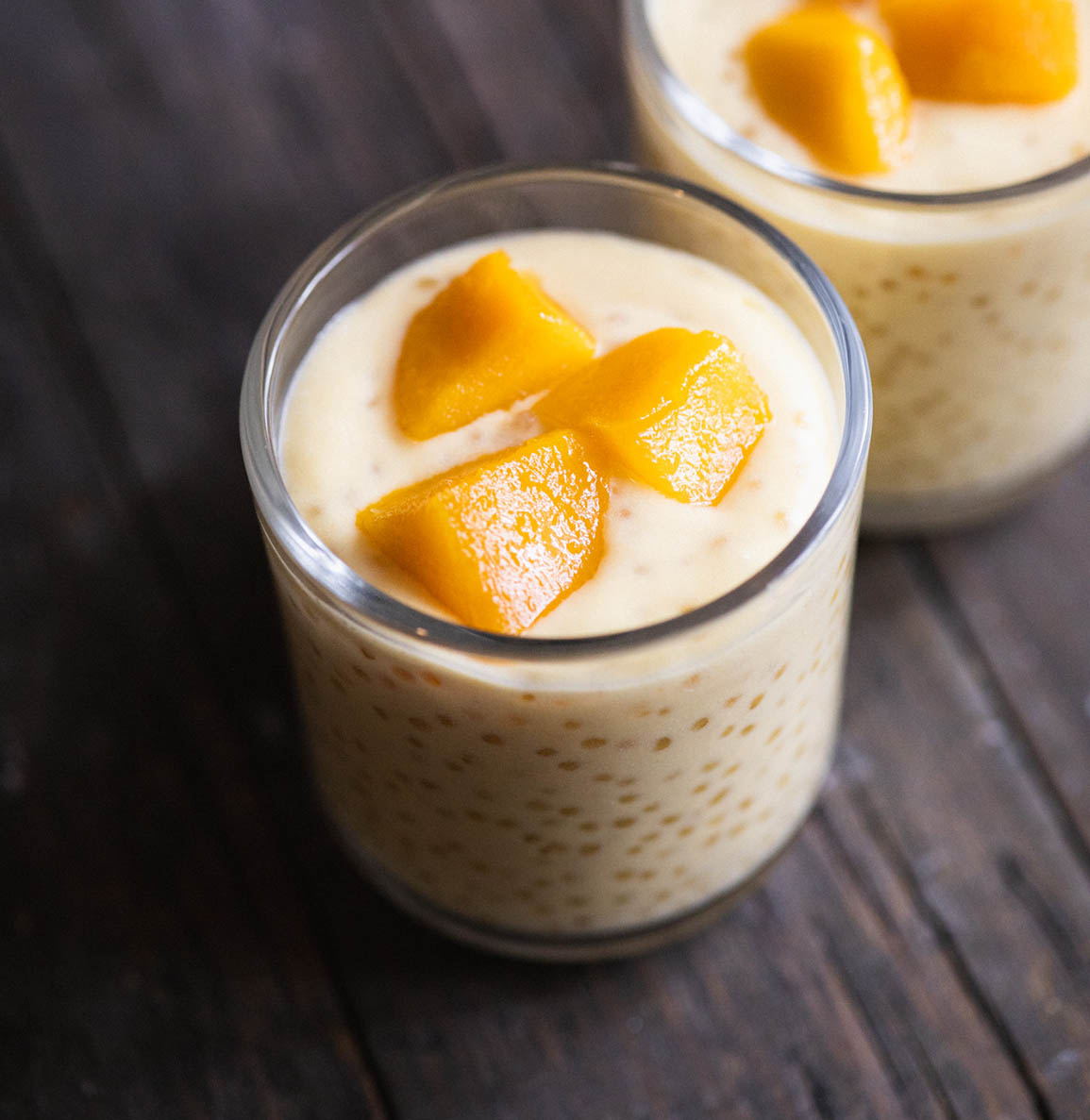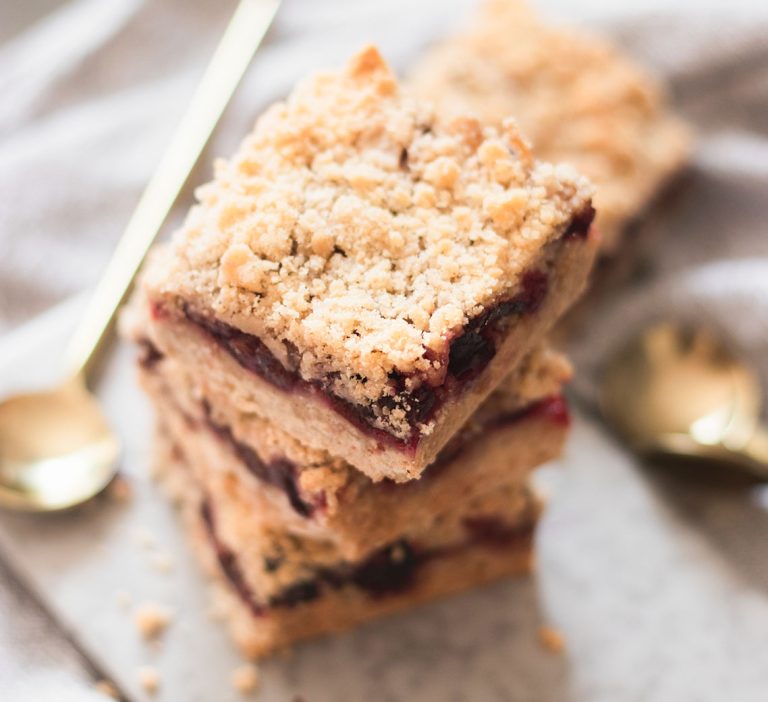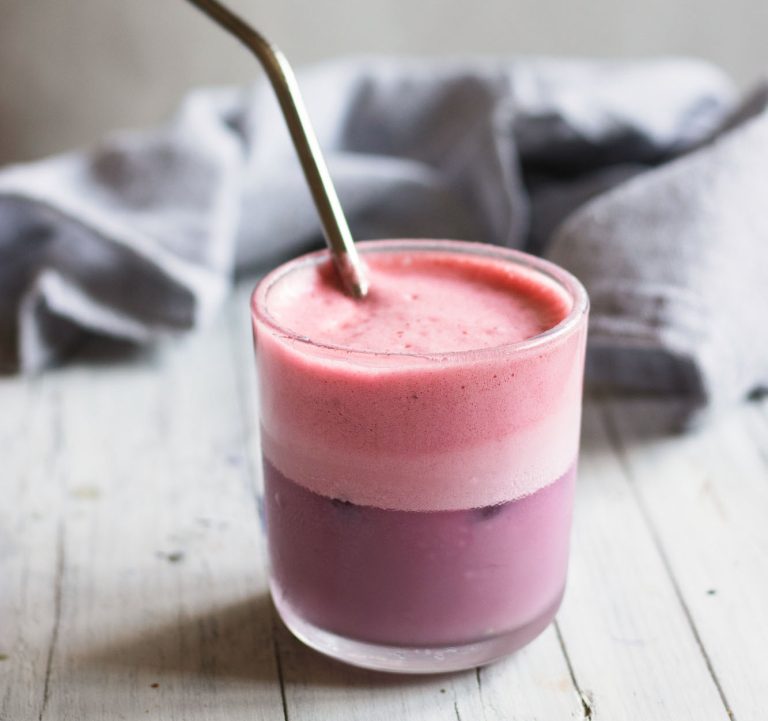Mango Tapioca Pudding
Today, I’ll share a recipe that’s not about seasonal eating or local produce, but simply something I genuinely love: mango tapioca pudding with coconut milk. If you’ve been following my blog, you already know about my soft spot for Asian desserts. Especially the gooey ones, haha.
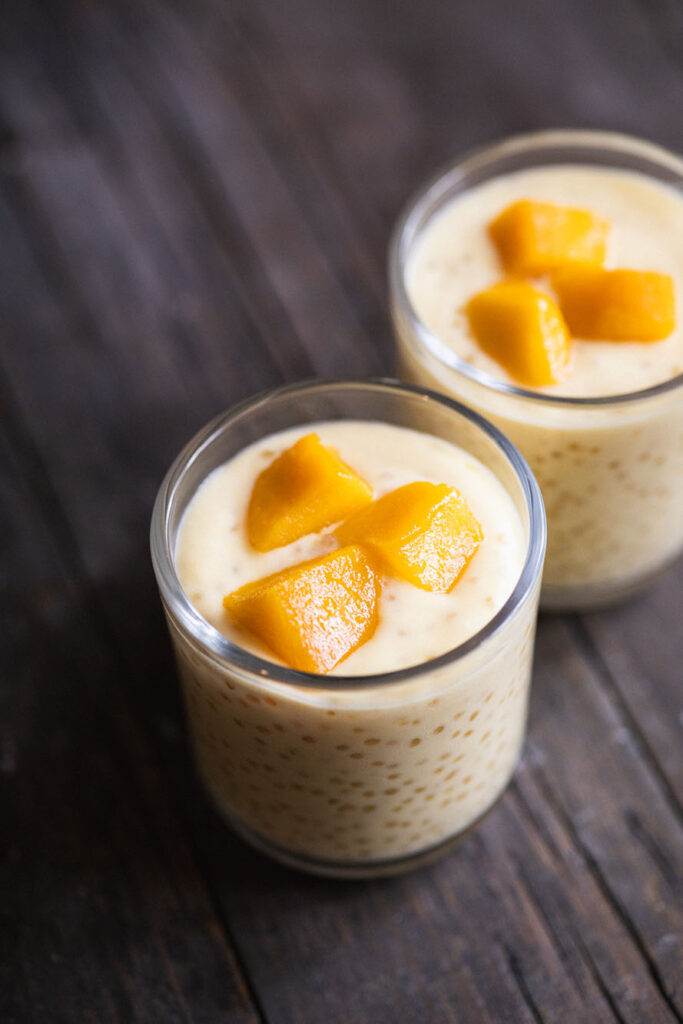
Well, this mango tapioca pudding is one of my all-time favourite desserts, and it’s so simple that it would be a shame not to share the recipe with you all. Made with only four ingredients – mango, tapioca pearls, coconut milk and your preferred sweetener – it’s the perfect easy dessert that always seems to impress. At least, my crowd can’t get enough of the mango and coconut combo.
You can make this mango dessert with either small tapioca pearls or sago – I’ll explain the difference later in this post. Also, don’t feel limited to just mango – this recipe is incredibly versatile and works perfectly with other fruits like peaches or strawberries, whether you use them instead of mango or mix them in.
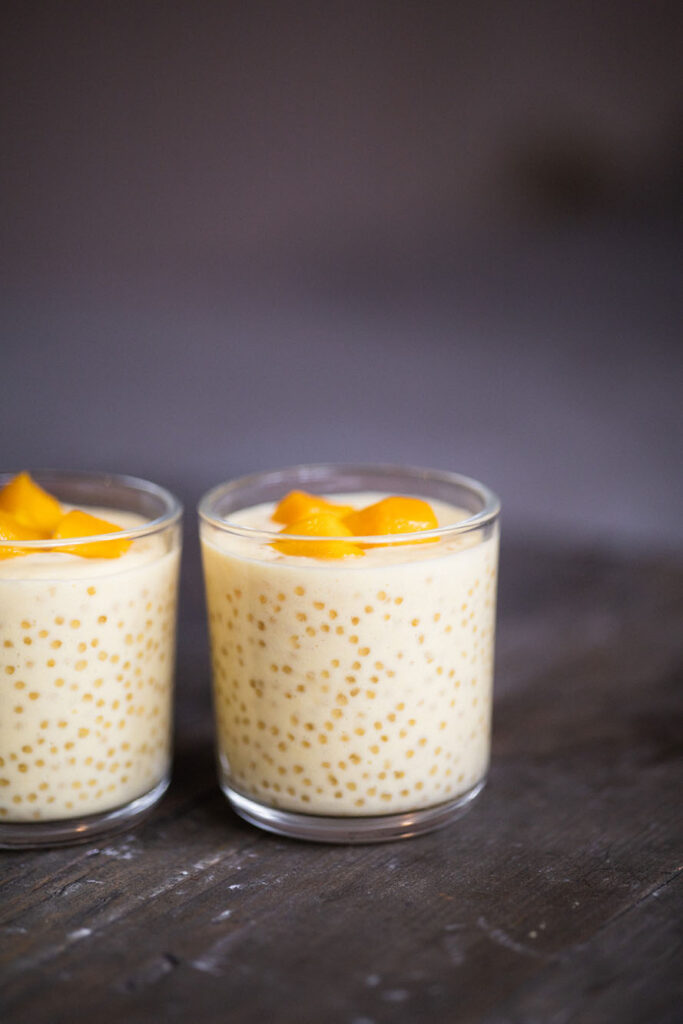
Mango tapioca pudding ingredients
To make this easy and delicious mango tapioca dessert, you’ll need only four ingredients:
- Small tapioca pearls (or sago – very similar starchy pearls).
- Fresh mango – if you can’t find it fresh, you can use frozen, dried or pureed – I’ll explain all the options later in the text.
- Full-fat coconut milk – with at least 60% coconut content, and the rest is ideally water (usually sold in 400 ml cans in Europe and the USA, like this product or similar).
- Sweetener of choice, such as agave or honey – optional, but I do recommend adding a bit to enhance the mango flavour. If you want to make it a lower-carb dessert but still use a sweetener, feel free to add xylitol or some other non-carb sweetener.
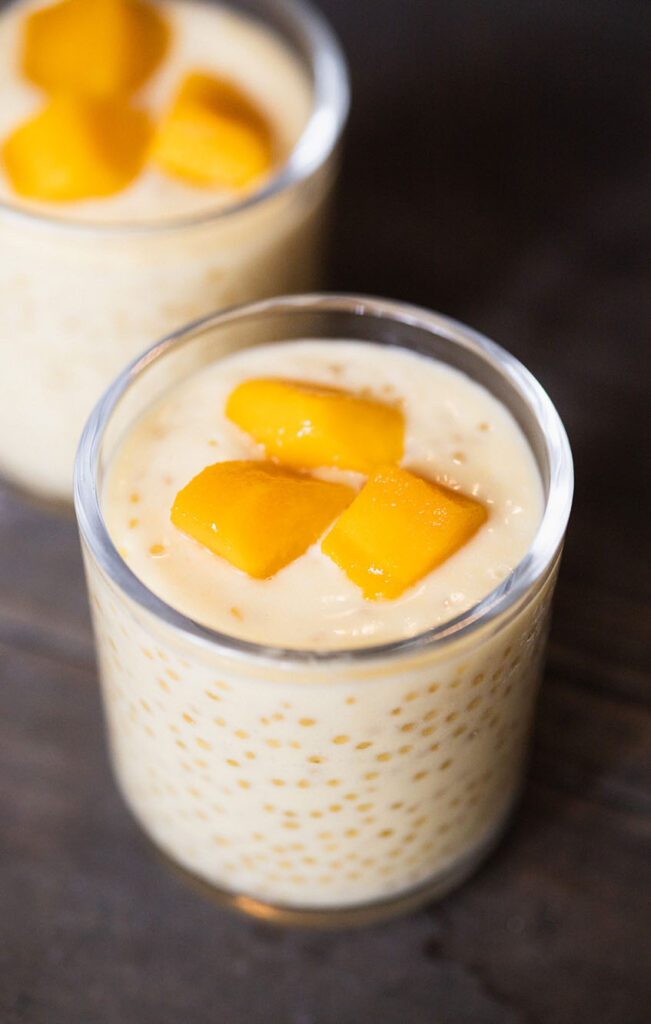
Tapioca pearls vs. sago
Many people often assume small tapioca pearls and sago are the same, and while they’re quite similar in application, their origins are entirely different. Tapioca pearls are derived from the starch of the cassava plant (Manihot esculenta), whereas sago comes from a distinct plant family, specifically Cycas revoluta and other cycads.
Here’s a little botanical side note for the curious: although Cycas revoluta is commonly known as the “sago palm,” it’s actually not a palm at all. It belongs to a completely different plant group. They do look somewhat similar, so people mistake them for palms. You might not have needed this tidbit, but there it is!
What makes sago and tapioca pearls so alike is that both are pure starch (just from different plant sources). This means they cook up in the same way, so for recipes like this pudding, it truly doesn’t matter which one you use – both will yield great results.
You’ll often come across “sago” recipes that actually call for tapioca pearls. This is mainly because tapioca pearls are generally more affordable and widely available in stores due to a simpler production process. But now, you know the real story behind true sago.
How to make mango tapioca pudding
Making this creamy, dreamy mango tapioca pudding is super easy. You’ll just need to follow three simple steps: cooking the tapioca pearls, making the mango and coconut puree, and then combining the two. After a quick chill in the fridge to cool down and thicken, your delicious dessert will be ready to enjoy!
Cooking Tapioca Pearls
Tapioca pearls are easy to cook if you know a few simple hacks.
First things first: for this recipe, always use small tapioca pearls, not the larger ones meant for bubble tea. I also recommend looking for brands that are 100% tapioca starch, like these ones.
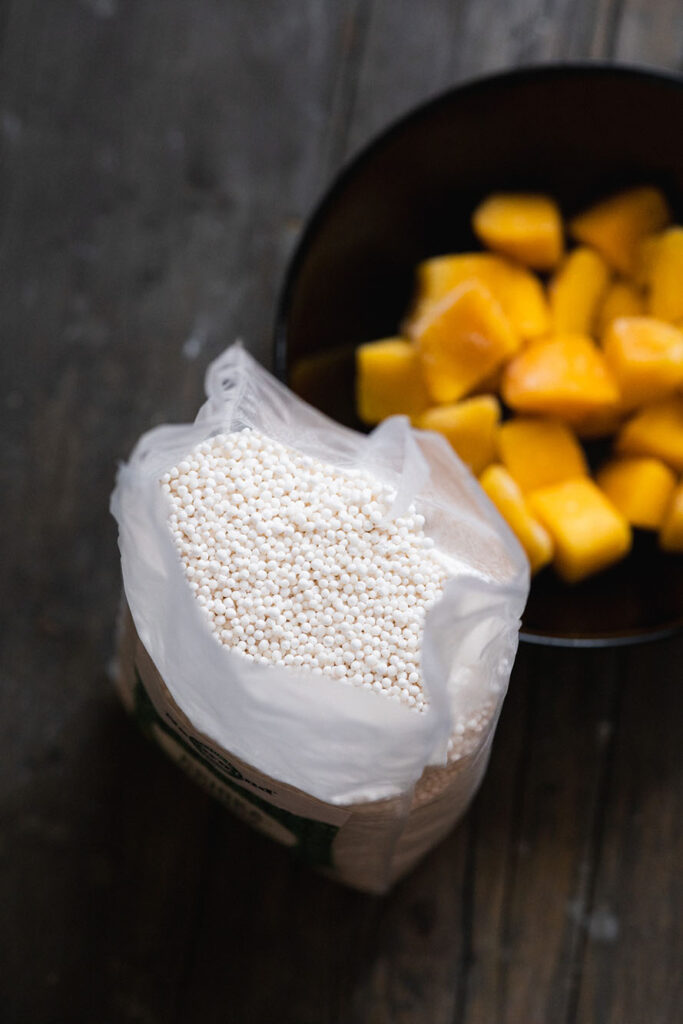
These pearls need a lot of room to expand properly, so make sure to use a generous amount of water. It’s crucial that the water is already at a rolling boil before you add the pearls. This helps them maintain their characteristic pearly, bubbly look and consistency.
Once the dried pearls are in the boiling water, lower the heat to medium-low. You want a gentle simmer, not an aggressive boil that splatters. Stir them every few minutes to prevent sticking to the bottom of the pot.

After about ten to fifteen minutes of cooking, your pearls should look mostly translucent, with just a tiny white dot remaining in the centre. Don’t be tempted to cook them longer, trying to get rid of that dot; it won’t disappear easily, and you’ll only risk overcooking them.
Finally, drain the cooked pearls in a fine-mesh metal strainer and rinse them thoroughly under cold water to cool them down. Once completely cool, set them aside in a bowl while you prepare the mango coconut puree. Since the puree comes together quickly, you won’t risk the pearls sticking or losing their perfect bubbly texture.

Making the mango and coconut puree
This is the easiest part – just peel your mango and remove the pit, slice it up and put it into a blender with coconut milk and your preferred sweetener. Blend until you get a super smooth, creamy puree.

And here are some options if you decide to use something else instead of the fresh mango.
Using frozen or dried mango
If fresh mango isn’t an option, feel free to use frozen or dried mango, or even unsweetened mango puree, for this recipe.
Frozen mango
If you’re opting for frozen, just make sure it’s fully defrosted before blending to get that perfectly smooth and creamy texture. Blending partially frozen chunks can lead to an inconsistent, less creamy result as they continue to thaw in the fridge.
However, if you plan to enjoy the desserts immediately, using frozen mango can actually be a cool option. Blending it while still icy will give you a more slushy / soft-serve / frozen dessert-like consistency, which is a fun twist that’s best enjoyed right away before it loses its nice texture in the fridge.
Dried mango
If you’re going with dried mango, rehydrate your slices in room-temperature water for a couple of hours to soften them. This is an important step if you want that nice and creamy consistency. They will rehydrate even quicker if you cut them into smaller pieces.
When using dried fruits in recipes like this one, I like to use the exact amount of water to rehydrate them that I’d use in the recipe itself (so I don’t toss any of that precious fruit flavour).
Now, for the numbers. It’s tricky to give exact measurements because dried mango slices vary, but this is a good calculation starting point: fresh mango is roughly 80-85% water, while dried mango is only about 10-20%.
This means for our recipe, you’ll need approximately 50-60 grams of dried mango. You’ll want to rehydrate this in up to 250 ml (one cup) of water. Personally, I’d go with slightly less water, around 200 ml. This dessert with fresh mango is already a bit on the softer side, and this recipe can tolerate a bit lower mango-coconut puree to tapioca ratio.
Mango puree
We don’t really have an abundance of affordable mango fruit here in Croatia since it’s all imported, so I’ve never tried this option with mango. But I have with other fruits that we do grow locally (such as strawberries and peaches), and it always worked great.
So, if you happen to have some ready-made mango puree, feel free to use it as a substitute for fresh mango. You’ll likely need about ¾ cup of puree, though if yours is particularly dense or sweet, you might even need a bit less. I know, I know – you’ll have to eye this one a bit. But the good news is, this recipe is quite forgiving and doesn’t demand super strict measurements!
Assembling the mango tapioca pudding
Now that you have both mango-coconut puree and cooked and cooled-down tapioca pearls ready, it’s time to assemble the desserts. Just mix the two components well, then use a small ladle to scoop the dessert into your serving glasses or jars.
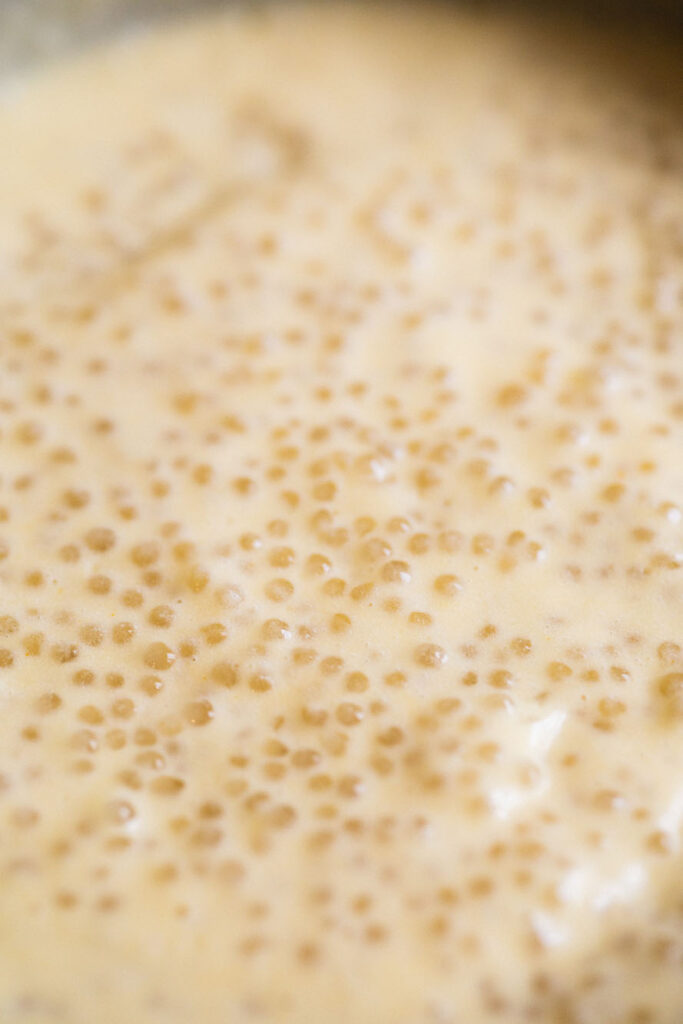
From my experience, this recipe makes six perfect portions. But feel free to adjust and make four larger servings or even eight smaller ones.
Don’t worry if the mixture seems a bit soft before chilling. The natural coconut oil present in the full-fat coconut milk will work its magic in the fridge and firm up the pudding to that perfectly creamy consistency. Just give it a few hours in the refrigerator to properly chill, and it’ll be ready to enjoy.

Storing mango tapioca pudding
This dessert is honestly at its best when enjoyed on the same day you make it. As time passes, the tapioca pearls unfortunately start to lose their beautiful chewy, gooey texture and begin to break down a bit. The pudding won’t go bad, but it will significantly lose its original charm and consistency.
Perhaps my years working as a chef in restaurants and other food industry jobs have spoiled me, but I’m usually not keen on eating this dessert by day two. My friends, however, are a bit more forgiving; for most of them, day three is when this pudding loses its appeal.
Since I hate wasting food, what I usually do to save any leftover portions – if they haven’t been eaten by day three (and yes, they’re still perfectly fresh, just past their prime texture-wise) – is pour them into popsicle moulds. This turns them into delicious, creamy mango popsicles that we all love to enjoy!
Recommended Kitchen Gear
Here are the kitchen essentials I recommend for making this easy mango tapioca pudding:
- Stainless steel cooking pot: For perfectly cooking the tapioca pearls.
- Fine mesh strainer: Crucial for draining and rinsing the cooked pearls.
- Large mixing bowl: For combining your tapioca and mango-coconut puree.
- Other glass bowls: Handy for prep work and keeping your ingredients organised.
- Knife and cutting board: For prepping your fresh mango (or rehydrated dried mango).
- High-speed blender: My personal go-to for all creamy desserts like this, but an immersion blender will also get the job done without a problem.
- Silicone spatula: For scraping down bowls and mixing everything thoroughly.
- Glasses or glass jars: For serving up your beautiful desserts.
Mango Tapioca Pudding
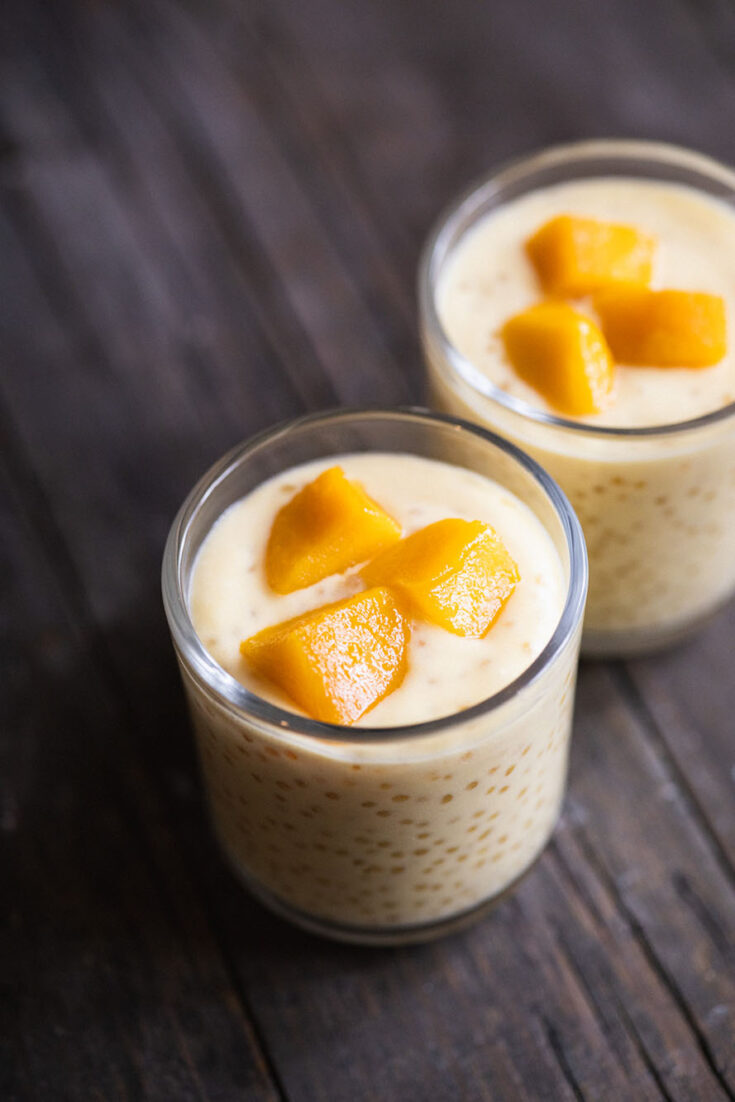
This delicious, healthy and easy-to-make mango tapioca dessert comes together in no time. Enjoy a creamy, satisfying treat with a lovely chewy texture of tapioca pearls and natural mango and coconut notes.
Ingredients
- 1 cup (150 g, 5.45 oz) small tapioca pearls
- 1 large mango or 2 small ones (approx. 300 g peeled and pitted)
- 1 can (400ml or 13.5 fl oz) full-fat coconut milk
- 2 tbsp sweetener of choice (e.g., honey, agave, maple syrup, xylitol)
- 5-6 cups (1250-1500 mL or 42-50 fl oz) water (for cooking tapioca)
Instructions
- Bring 5-6 cups of water to a rolling boil in a pot.
- Add the dried tapioca pearls.
- Let it get back to a boil and lower the heat to medium-low.
- Let the tapioca pearls simmer in a half-closed pot for 10-15 minutes or until they get translucent and soft. Mix it regularly to avoid sticking to the bottom of the pot.
- When the tapioca pearls look mostly translucent, with a small white dot in the middle, they are cooked.
- Once cooked, strain the tapioca pearls through a fine-mesh strainer. Immediately rinse them thoroughly under cold tap water until completely cooled.
- Let them drain well, then transfer to a large bowl and set aside.
- To make the mango and coconut puree, start by peeling and slicing a mango and removing the pit. (Refer to the notes below or the main post for instructions if using frozen, dried mango, or mango puree.)
- Transfer the mango slices to a blender, add the full-fat coconut milk and your preferred sweetener.
- Blend until the mixture is completely smooth and creamy.
- Assemble the pudding - combine the mango and coconut puree with the cooked and cooled tapioca pearls in the large bowl. Mix well until evenly combined.
- Ladle the mixture into your serving glasses or jars.
- Place the desserts in the fridge for a few hours to chill thoroughly and allow them to firm up to their perfect creamy consistency.
- Serve cold, ideally topped with fresh mango slices.
Notes
Sweetener options: This dessert is really tasty even without added sweeteners, as the fruit and coconut milk create a delicious base. If you prefer it sweeter but want to minimise carbs, feel free to use xylitol or another low-carb sweetener you enjoy.
Mango alternatives:
Frozen mango: For the creamiest result, ensure frozen mango is fully defrosted before blending. If you plan to eat the pudding immediately, blending it while still a bit icy is fine; it will result in an ice cream-like texture that's a fun twist.
Dried mango: To substitute 300g of fresh mango, use approximately 60 grams of dried mango. Rehydrate the dried slices by soaking them in 200 ml of room-temperature water for a few hours until soft. Use all the rehydration water along with the softened mango in the recipe (do not drain).
Cooling tapioca: While you can transfer cooked tapioca pearls into a large bowl of ice-cold water, I find simply running them under a stream of cold tap water until completely cooled works just as well.
Storing the mango tapioca pudding: Store in the fridge, and for the best consistency, consume within 24 hours. The dessert will not “go bad” for the next few days for sure, but tapioca pearls will lose their unique gooey texture that makes them so special in this dessert.
If you find yourself with leftovers after a day or two and notice the tapioca pearls have started to soften and break down, don't throw it out! Give the mixture a good stir and transfer it into popsicle moulds. This is my go-to trick for turning a texture-compromised pudding into delicious, creamy mango popsicles.

